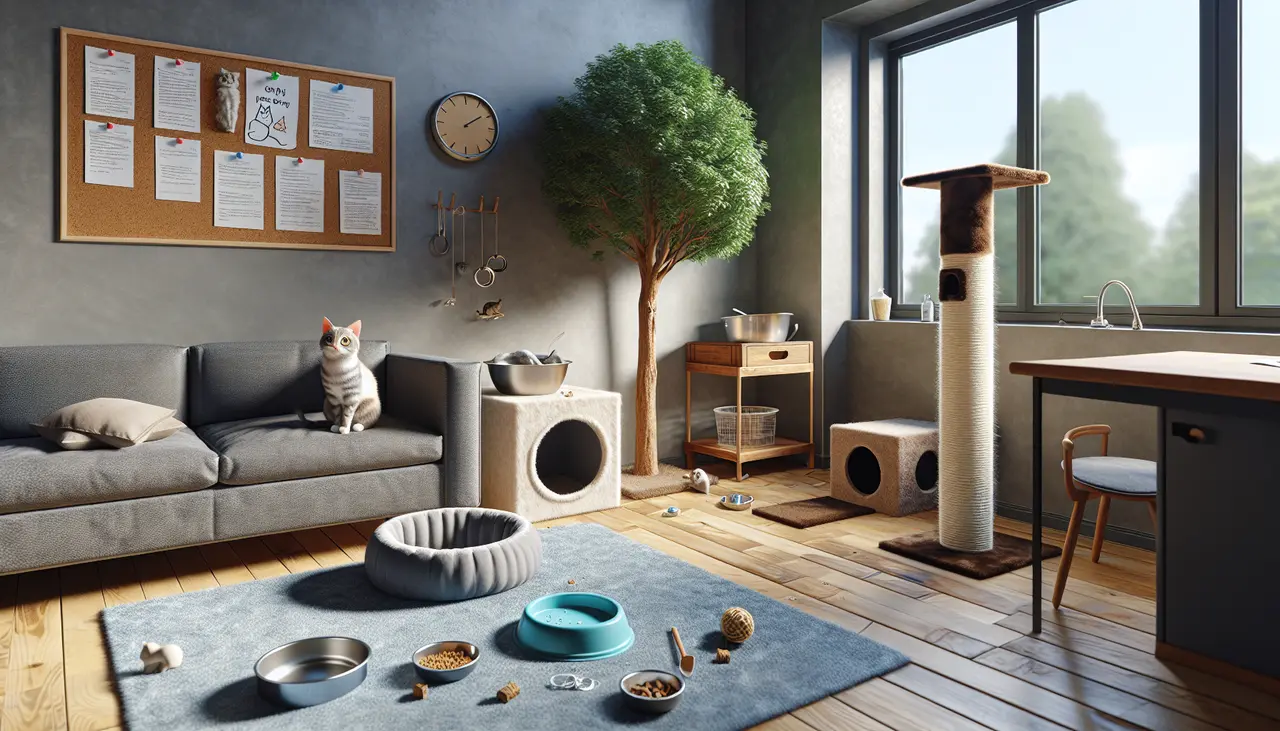Understanding the basics of cat-sitting
Cat sitting is like being a temporary guardian for your furry friend while you’re away. It’s more than just feeding them; it’s ensuring they’re happy and comfortable, too. First things first, know your cat’s routine. Cats love their routine. Feeding, playtime, nap time—keep it all as normal as possible. Next, safety is key. Make sure your home is safe for the cat. No loose wires to chew on or small, swallowable objects lying around. Lastly, leave clear instructions for your cat sitter. From your cat’s diet to their favorite hiding spots, the more they know, the better they can care for your cat. And remember, a happy cat means a happy return home.
Preparing your cat for a cat sitter
Getting your cat ready for a cat sitter is simpler than you might think. First, ensure your cat’s routine stays the same even when you’re away. Cats love their routine. Feed them, play with them, and clean their litter simultaneously every day. Next, leave clear instructions for the sitter. Include your cat’s meal times, favorite toys, and how they like to be petted. Third, introduce your cat to the sitter before you leave, if possible. A quick meet-up can make your cat less anxious and more comfortable with the new person in their space. Lastly, update your cat’s ID and microchip information. It’s a safety net you won’t regret. Doing these steps ensures your cat and the sitter have a smooth time while you’re away.
Creating a comfortable environment for your cat
Creating a space where your cat feels at ease while you’re away is key. Remember, cats love routine and familiar surroundings. Start by making sure their favorite spots are easily accessible. Whether it’s a sunny window ledge or a cozy corner, keeping these areas open for them means they can stick to their usual haunts. Next, think about noise. A too-quiet house can be just as stressful as a noisy one. Leave a radio on low or set up a playlist of calming music. This mimics the normal sounds of home life. Don’t overlook the importance of play. Leave out toys they adore. It’s not just about keeping them entertained—play is crucial for their mental health. Lastly, consider scent. Cats rely heavily on their sense of smell to feel secure. Keep a piece of clothing you’ve recently worn in their sleeping area. Your scent can be a big comfort to them. Remember, a relaxed cat is a happy cat. Your efforts to maintain their comfort won’t go unnoticed.
Essential supplies checklist for cat sitting
Before you take off and leave your fur baby with a cat sitter, make sure your home is stocked with the essentials. Your cat’s comfort and the sitter’s convenience should be top priorities. Here’s a straightforward checklist: Food and Water Bowls: Clearly, your cat needs to eat and stay hydrated. Stock up on their regular food to avoid any dietary upsets. Litter Box and Scoop: Essential for obvious reasons. Leave clear instructions on where extra litter can be found. Toys and Treats: These keep your cat entertained and can help them bond with the sitter. Safety Gear: Make sure all windows and doors are secure. Leave a note about any special locks or alarms. Emergency Contacts: Vet details, your contact info, and a backup contact should be easily accessible. Medications and Instructions: If your cat is on any medication, leave detailed instructions on dosage and timing. Comfort Items: A favorite blanket or pillow can help ease your cat’s stress while you’re away. Keep it simple and clear. Your sitter and cat will thank you.
Instructions to leave for your cat sitter
Leaving instructions for your cat sitter is crucial to ensure your cat’s routine stays as normal as possible while you’re away. Make sure to write down the basics: feeding times, portion sizes, and your cat’s favorite treats. Don’t forget to mention any special dietary needs or medications your cat requires. Include details about your cat’s habits, like their favorite hiding spots or toys. Provide emergency contact information, including your vet’s number and a nearby friend or relative. Lastly, let them know about any house rules or areas off-limits to your cat. Clear instructions help your cat sitter provide the best care and keep your furry friend comfortable and stress-free.
Safety measures for cat sitting in your home
When you’re away and someone else is caring for your cat, making sure your home is safe for both the sitter and your cat is key. Start by securing all windows and doors to prevent escapes, a common worry. Cats are curious; remove or lock up hazardous items like cleaning supplies, human food that’s toxic to cats, and small objects they could swallow. Check that plants in your home aren’t poisonous to cats. Next, ensure your cat’s environment is safe and comfortable. Keep their water bowl full and accessible, make sure the litter box is clean to encourage use, and ensure their favorite resting spots are cozy and undisturbed. Leave detailed instructions for the sitter. Include your vet’s contact info, your cat’s feeding schedule, any medication instructions, and how to use any security systems. Communication is crucial. Ask your sitter to send daily updates and photos to keep your mind at ease. By taking these steps, you can create a safe, stress-free environment for your cat and the sitter, ensuring peace of mind while you’re away.
How to find and choose the right cat sitter
Finding the right cat sitter isn’t just about picking someone who likes cats. It’s crucial to find someone who knows how to handle cats, understands their needs, and respects your home. Start by asking friends or family for recommendations; someone you trust who’s had a good experience can point you in the right direction. If that doesn’t work, check out online platforms or local pet sitting services, making sure to read reviews and ratings carefully.
Interview potential sitters to see if they mesh well with your cat’s personality and ask about their experience with cats, especially if yours has special needs or health issues. It’s not nosy to request references from past clients—this is standard and helps ensure your cat’s in good hands. Also, consider whether you want someone to stay in your home or just visit, as this might affect your choice.
Lastly, trust your gut. If you or your cat doesn’t seem comfortable with the person, keep looking. Your peace of mind and your cat’s comfort are paramount.
Setting up communication with your cat sitter
Setting up clear communication with your cat sitter is crucial. Before leaving, give them a quick tour of your home, showing where the cat’s essentials are. Make sure they have your contact information and details of a backup contact, in case you can’t be reached. Also, discuss how often and through what means you want updates about your cat. Some people prefer daily texts with photos, while others might just want a call now and then. Let them know your cat’s habits, like their favorite hiding spots or how they tell you they’re hungry. This info helps your cat sitter respond better to your cat’s needs, making the whole experience smoother for everyone involved.
What to do in case of an emergency
Emergencies can strike without warning, so being ready is key. First off, make a list of important numbers. This includes your vet, a 24-hour emergency vet clinic, and your own contact info. Give this list to your cat sitter. Talk to your sitter about any health issues your cat has or medications they need. Make sure they know where the cat carrier is in case a quick exit or trip to the vet is needed. Also, leave clear instructions on what to do in different types of emergencies, like if your cat stops eating or if there’s an unexpected injury. It’s always better to over-prepare than to find yourself wishing you had.
Wrapping up: Ensuring a smooth cat sitting experience
To ensure a smooth cat sitting experience, clear communication is key. Before you head out, have a quick walk-through with your sitter. Show them where the essentials are – food, water bowls, litter box, and any hiding spots your kitty loves. Write down your cat’s routine, including feeding times, preferred playtimes, and any quirks they should be aware of. It’s also wise to leave your vet’s contact info and any instructions for emergencies. Trust is crucial. Make sure your sitter knows how to reach you and feels comfortable asking questions. Remember, a happy sitter leads to a happy cat. With these steps, you’re setting up for a stress-free time away, knowing your furry friend is in good hands.

















